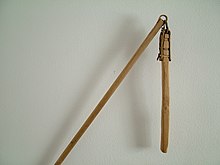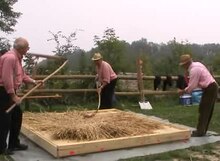Flail
The flail (in South / Altdeutschen also Dreschschlegel ) is an old rustic tool for threshing the crop after harvesting , to be able to supply the cereal grains to further processing. Flegel is a Romanic loan word (from Latin: flagellum ) and probably came from the Roman Empire in the Germanic language area.
Agricultural use
The flail consists of a wooden handle to which the actual flail is attached by means of a movable component (usually made of leather ) . This is a roughly 6–8 cm thick, roughly worked wooden stick made of hardwood. Threshing took place on the fortified floor of a barn called the threshing floor . The entire flail was hurled through the air with the handle in such a way that the club attached to the front hit the grain bundles lying on the ground with great force. In this way the grains of grain were knocked out of the ears (threshed). As a rule, the barns with a threshing floor were designed so that they could be opened on two opposite sides. This allowed the wind to “sweep” through the barn (especially in autumn). With the flail you hit the grain, which, with the right rhythm and power, flew into the air. The heavy grain fell to the ground and the light parts, such as straw and chaff , were swept over the threshing floor by the wind. (Cf. also in the Bible, Mt. 3, 12, “Separating the wheat from the chaff”.) A so-called winnow was also used for this .
Separating the chaff from the grain was more difficult. The farmers put grains and chaff in a flat basket, the winnowers. With the winnow, which now served as a sieve, they threw both up. The wind blew the lighter chaff to one side and the grain fell back into the winnowing. If this was repeated several times, there were only grains in the winnow at the end. In this way, the grain obtained in this way can later be processed into flour in a mill . When threshing with the flail, farmers stood around the grain spread out on a hard surface ( threshing floor ) and beat the flails one after the other on the pile of grain. To do this, they had to get in tune with each other in order to find the right threshing cycle.
The flail was, next to the shepherd's crook , the most important attribute of the Egyptian god Osiris . In modern agriculture in Germany, the flail was only replaced by the threshing machine at the beginning of the 20th century and then, in the 1950s and 1960s, by the combine harvester . A practical use of the threshing flail is still in plant breeding or seed growing operations for threshing out small batches of seeds, where cleaning even a small threshing machine would be more time-consuming.
In the Baden and Wuerttemberg region, the flail was also called "threshing swivel" or "swan" until the beginning of the 20th century. From this z. B. also easements such as the " Schwengelrecht ".
Flail as a weapon
Since the flail can develop enormous power, it was often used as a simple peasant weapon in the Middle Ages, like the war scythe . Most of the peasants fought with these two weapons in the German Peasants' War , during the Hussite Wars flails were one of the best-known and most effective weapons of the Hussite army. The nunchaku , known from the Asian martial arts, is also a flail that the farmers used to thresh rice. It is possible that the flail and / or the morning star later developed from this temporary arrangement .
Term flail in a broader sense
A flail in the transferred sense of a person is someone who ruthlessly verbally threshes empty straw or who, in the opinion of many other people, behaves contrary to the usual forms of behavior. As an exclamation, the word shows subjective concern from the behavior. The origin of the term flail as a name for a person is not certain, but its use in this sense can be proven.
Others
Newspaper: Flail , National Socialist Kampfblatt in the Halver area from 1932
Book title: The flail - insubordinate folk songs from Austria ( Martin Auer with Reinhart Honold and Rudi Tinsobin). Songbook, "Die Komödianten", Vienna 1977.
literature
- Wolfram Hennies, From flail to threshing machine. On the history of the Perleberg agricultural machinery industry in the 19th century . Volume 1 of Perleberger Hefte, Perleberg, Verlag Rat der Stadt Perleberg, 1989.
- Franz Xaver Hlubek : Agriculture in its entirety based on the experience and knowledge of the last 100 years. Presented with scientific rigor . Volume 1, Verlag Braumüller and Seidel, Vienna 1846, p. 331, § 736, § 737
- Dag defiant : Slagan och andra tröskredskap: En etnologisk undersökning med starting point från svenskt material. Stockholm 1943 (= Nordiska Museets Handlingen , 17).
Web links
Individual evidence
- ^ Ulrich Sachweh (editor): The gardener, Volume 3, tree nursery, fruit growing, seed growing, vegetable growing. 2nd edition, Ulmer, Stuttgart 1986/1989, ISBN 3-8001-1148-9 , p. 337.
- ↑ For example: DWS entry with quotations from German literature .

